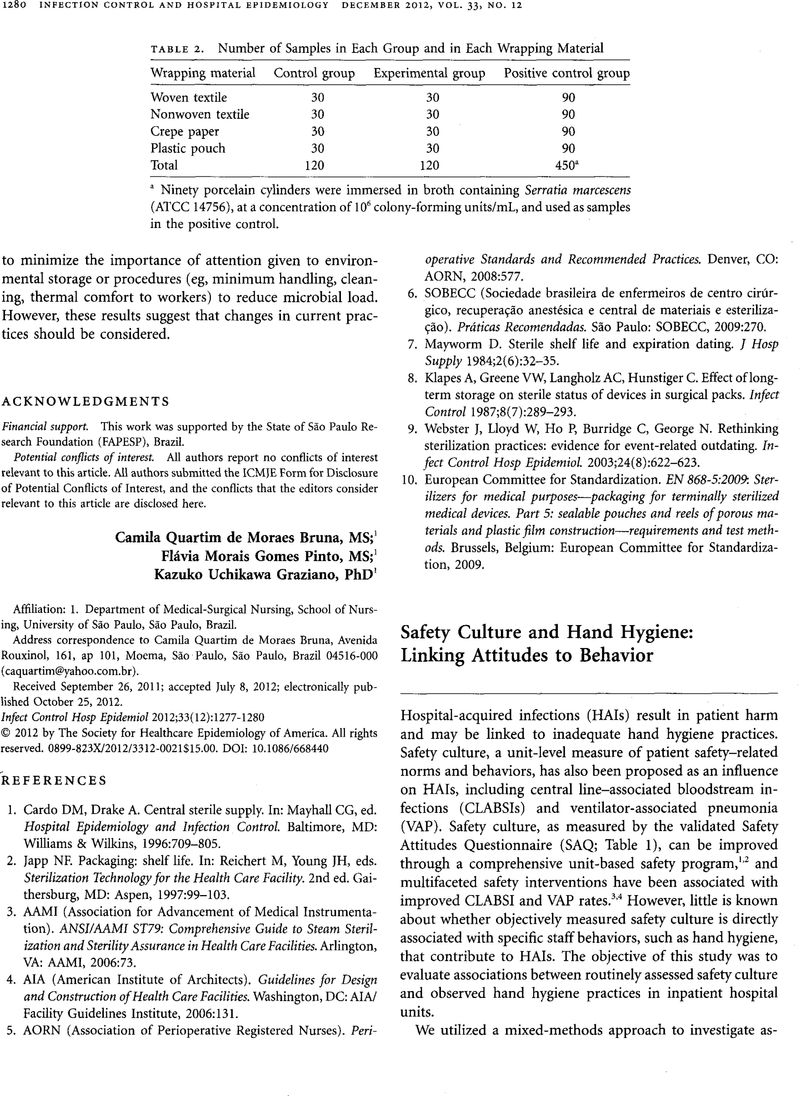Crossref Citations
This article has been cited by the following publications. This list is generated based on data provided by Crossref.
Sexton, J Bryan
Sharek, Paul J
Thomas, Eric J
Gould, Jeffrey B
Nisbet, Courtney C
Amspoker, Amber B
Kowalkowski, Mark A
Schwendimann, René
and
Profit, Jochen
2014.
Exposure to Leadership WalkRounds in neonatal intensive care units is associated with a better patient safety culture and less caregiver burnout.
BMJ Quality & Safety,
Vol. 23,
Issue. 10,
p.
814.
Profit, Jochen
Sharek, Paul J
Amspoker, Amber B
Kowalkowski, Mark A
Nisbet, Courtney C
Thomas, Eric J
Chadwick, Whitney A
and
Sexton, J Bryan
2014.
Burnout in the NICU setting and its relation to safety culture.
BMJ Quality & Safety,
Vol. 23,
Issue. 10,
p.
806.
Yanes, Arianna F
McElroy, Lisa M
Abecassis, Zachary A
Holl, Jane
Woods, Donna
and
Ladner, Daniela P
2016.
Observation for assessment of clinician performance: a narrative review.
BMJ Quality & Safety,
Vol. 25,
Issue. 1,
p.
46.
Profit, Jochen
Lee, Henry C
Sharek, Paul J
Kan, Peggy
Nisbet, Courtney C
Thomas, Eric J
Etchegaray, Jason M
and
Sexton, Bryan
2016.
Comparing NICU teamwork and safety climate across two commonly used survey instruments.
BMJ Quality & Safety,
Vol. 25,
Issue. 12,
p.
954.
Gallagher, Diane
2016.
Crew resource management...following up.
Nursing Management,
Vol. 47,
Issue. 7,
p.
50.
Dreidi, Mu’taz M.
Alrimawi, Intima
Saifan, Ahmad R.
and
Batiha, Abdul-Monim
2016.
Hand Hygiene Knowledge, Practices and Attitudes among Nurses and Physicians.
Health,
Vol. 08,
Issue. 05,
p.
456.
Sexton, J Bryan
Adair, Kathryn C
Leonard, Michael W
Frankel, Terri Christensen
Proulx, Joshua
Watson, Sam R
Magnus, Brooke
Bogan, Brittany
Jamal, Maleek
Schwendimann, Rene
and
Frankel, Allan S
2018.
Providing feedback following Leadership WalkRounds is associated with better patient safety culture, higher employee engagement and lower burnout.
BMJ Quality & Safety,
Vol. 27,
Issue. 4,
p.
261.
Bernard, Laurence
Biron, Alain
Lavigne, Geneviève
Frechette, Julie
Bernard, Agnès
Mitchell, Jonathan
and
Lavoie‐Tremblay, Mélanie
2018.
An exploratory study of safety culture, biological risk management and hand hygiene of healthcare professionals.
Journal of Advanced Nursing,
Vol. 74,
Issue. 4,
p.
827.
Livorsi, Daniel J.
Goedken, Cassie Cunningham
Sauder, Michael
Vander Weg, Mark W.
Perencevich, Eli N.
and
Reisinger, Heather Schacht
2018.
Evaluation of Barriers to Audit-and-Feedback Programs That Used Direct Observation of Hand Hygiene Compliance.
JAMA Network Open,
Vol. 1,
Issue. 6,
p.
e183344.
Dunstan, Elspeth
Cook, Jane-Louise
and
Coyer, Fiona
2019.
Safety culture in intensive care internationally and in Australia: A narrative review of the literature.
Australian Critical Care,
Vol. 32,
Issue. 6,
p.
524.
Schwartz, Stephanie P
Adair, Kathryn C
Bae, Jonathan
Rehder, Kyle J
Shanafelt, Tait D
Profit, Jochen
and
Sexton, J Bryan
2019.
Work-life balance behaviours cluster in work settings and relate to burnout and safety culture: a cross-sectional survey analysis.
BMJ Quality & Safety,
Vol. 28,
Issue. 2,
p.
142.
Dunstan, Elspeth
and
Coyer, Fiona
2020.
Safety culture in two metropolitan Australian tertiary hospital intensive care units: A cross-sectional survey.
Australian Critical Care,
Vol. 33,
Issue. 1,
p.
4.
Braun, Barbara I.
Chitavi, Salome O.
Suzuki, Hiroyuki
Soyemi, Caroline A.
and
Puig-Asensio, Mireia
2020.
Culture of Safety: Impact on Improvement in Infection Prevention Process and Outcomes.
Current Infectious Disease Reports,
Vol. 22,
Issue. 12,
Profit, Jochen
Sharek, Paul J.
Cui, Xin
Nisbet, Courtney C.
Thomas, Eric J.
Tawfik, Daniel S.
Lee, Henry C.
Draper, David
and
Sexton, J. Bryan
2020.
The Correlation Between Neonatal Intensive Care Unit Safety Culture and Quality of Care.
Journal of Patient Safety,
Vol. 16,
Issue. 4,
p.
e310.
Tartari, Ermira
Kilpatrick, Claire
Allegranzi, Benedetta
and
Pittet, Didier
2022.
“Unite for safety – clean your hands”: the 5 May 2022 World Health Organization SAVE LIVES—Clean Your Hands campaign.
Antimicrobial Resistance & Infection Control,
Vol. 11,
Issue. 1,
Tartari, Ermira
Kilpatrick, Claire
Allegranzi, Benedetta
and
Pittet, Didier
2022.
“Unite for safety – clean your hands”: The 5 May 2022 World Health Organization SAVE LIVES: Clean your hands campaign.
American Journal of Infection Control,
Vol. 50,
Issue. 5,
p.
588.
Tartari, E.
Kilpatrick, C.
Allegranzi, B.
and
Pittet, D.
2022.
“Unite for safety – clean your hands”: the 5 May 2022 World Health Organization SAVE LIVES: Clean Your Hands campaign.
Journal of Hospital Infection,
Vol. 123,
Issue. ,
p.
108.
Frödin, Maria
Rogmark, Cecilia
Nellgård, Bengt
Gillespie, Brigid M.
Wikström, Ewa
and
Andersson, Annette E.
2023.
Interactive Interventions Can Improve Hand Hygiene and Aseptic Techniques During Perioperative Care—Experience From the “Safe Hands” Project.
Journal of PeriAnesthesia Nursing,
Vol. 38,
Issue. 2,
p.
284.
Zhong, Jie
Simpson, Kathleen Rice
Spetz, Joanne
Gay, Caryl L.
Fletcher, Jason
Landstrom, Gay L.
and
Lyndon, Audrey
2023.
Linking Patient Safety Climate With Missed Nursing Care in Labor and Delivery Units: Findings From the LaborRNs Survey.
Journal of Patient Safety,
Vol. 19,
Issue. 3,
p.
166.
Tartari, Ermira
Storr, Julie
Bellare, Nita
Kilpatrick, Claire
McGuckin, Maryanne
Schwaber, Mitchell J
Pittet, Didier
and
Allegranzi, Benedetta
2024.
WHO research agenda on the role of the institutional safety climate for hand hygiene improvement: a Delphi consensus-building study.
BMJ Quality & Safety,
p.
bmjqs-2024-017162.



